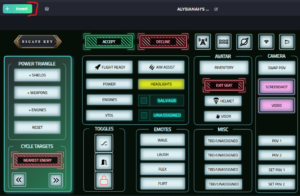[vc_row][vc_column width=”2/3″][vc_column_text]I have Star Citizen Alpha 3.0 on my mind. I’m so pumped to start seeing the non-combat professions integrated into the persistent universe. Casual Citizen episode 25 discusses the flight-ready cargo ships we’ll have at our disposal to test out the first implementation of cargo hauling. Check it out on YouTube or SoundCloud to be sure you’re ready to hit the ground running.
- YouTube Version
- SoundCloud audio-only version
SHOW NOTES
Flight Ready Cargo Ships
- Argo Cargo
- Aurora CL
- Reliant Kore
- Avenger Titan
- MISC Freelancer
- Constellation Andromeda
- MISC Starfarer
- Starfarer Gemini
Hull B Q&A Post with updated Cargo Sizes
SHOW TRANSCRIPT
BEGIN TRANSMISSION.
WHAT’S IN AND WHAT’S OUT
Originally, I was going to limit the conversation to the ships CIG has flagged as “cargo ship” on RobertsSpaceIndustries.com. However, two popular ships are missing if I did that – the Cutlass Black and Constellation Andromeda, which I’ve decided to include. Whereas I haven’t included the Mustang Alpha because it requires the optional cargo carrier which has yet to materialize in game.
REAL CARGO SIZES PLEASE STAND UP
Unfortunately, there are conflicts between the cargo capacity for the ships listed in the actual ship stats versus updated sizes that were published as part of the MISC Hull B Q&A. This is rather unfortunate, since the average player isn’t likely to see the updated cargo size information. With the exception of the Argo Cargo and the Starfarer Gemini, which weren’t on the updated list, I’m going to reference the sizes from the Hull B Q&A post, which I will link in the show notes.
For the Argo Cargo I pulled the value from the brochure. For the Gemini, I used the updated size for the refueling variant but applied the reduced capacity percentage witnessed on the their respective technical overview pages.
Directly from RSI Cargo Chart
Cubic meters? Freight Units? Standard Cargo Units?! We’ve gone through several iterations for measuring cargo, to the point that our own design team has confused the two on occasion. Today, we’re setting the record straight with a ‘master’ list. Dan Tracy has measured every ship currently ‘in-engine’ and made estimates for others (such as the Merchantman) which are not. As of today, this is the definitive list of cargo capacity and these numbers will be applied to the stats page. Please pay special intent to the comparative sizes rather than simply the number; these are the best indicator of where these ships are intended to fall on the spectrum, regardless of the units of measurement we use.
The inability to get most accurate or updated cargo information more easily, is a bit unfortunate for this particular class of ship. There’s updated information available it’s just not where people would be looking for it.
Now that understanding where and how I obtained the cargo sizes you’ll hear me reference, is out of the way, let’s begin. I’ll be discussing the ships in order of available cargo capacity – smallest to largest. To reiterate, these are FLIGHT READY cargo ships.
WHY CARGO HAULING?
Let’s begin by defining cargo hauling as I suspect there will be varying definitions. Establishing mine is important for data I’ll share in a bit and what’s available on Alysianahsworld.com.
I differentiate between trade and cargo hauling. For me, cargo hauling is picking up goods in one place and delivering them to another. You have no ownership of the items being transported. You don’t know or care what they cost to acquire. You’re not involved in selling them. You’re merely the bus driver.
Merchants and traders care about the cost to purchase goods versus the resale value. Traders and merchants earn revenue from selling of goods. Cargo haulers are paid to transport goods. I think cargo hauling will be a good active profession for players of a certain play style and an excellent passive profession for most everyone. I personally, only plan to do cargo hauling as a secondary, passive mode of generating income. If I’m going that way and have the space available on my ship, by all means I’ll deliver those goods for ya.
MONEY MAKES MMOS GO ‘ROUND.
The persistent universe side of Star Citizen will contain many of the common trapping of any MMO. Specifically, you’ll need a way to earn in-game currency to support yourself. In this case, support fueling, arming, repairing and possibly upgrading your ship. You may want to do the same for your character, such as obtain better armor and weapons. You’ll have insurance premiums to pay. You’ll have hangar fees to pay. Money. Money. Money. For most players, your existence in the Star Citizen universe will require you to earn a living in game.
For those who don’t want to focus on combat as a means of earning currency. Or who aren’t particularly interested in having PVE missions dictate their actions, cargo hauling is a viable incoming generating profession. You can obtain work via contracts that will be available on the Trade and Development Division job boards. You can accept cargo transport specific missions. You can shuttle cargo for other players. All of this while seeing the world. Cargo hauling is also one of the player professions that can more easily be done solo, if that’s your preference.
CARGO SHIPS AVAILABLE IN ALPHA 3.0
Alpha 3.0 is going to give us our first taste of cargo hauling. I suspect we’ll see cargo missions from NPCs. I anticipate being able to pick up work at the Trade and Development Division locations, such as Job Well in ArcCorp Area 18. The physical implementation in game is likely to contain placeholder activity for loading and unloading cargo. Similar to the placeholder implementation for ship repairs in we’re using for Cry-Astro. In other words, there’ll be some handwavium going on.
Bringing cargo hauling online will also innately bring with it opportunities for other player professions and play styles such as piracy and mercs. You need to keep these these things in mind if you’re going to pursue moving merchandise. Space and be a dangerous and unforgiving place. Common sense and situational awareness will be important. I’m crossing my fingers that ship security comes online with cargo otherwise, lots of unnecessary tomfoolery will take place on landing pads that will be 100% outside of a pilot’s ability to control.
If you want to take part in the early alpha testing of cargo hauling, let’s take a look at ships that are flight ready and have cargo space available.
ARGO CARGO
From CIG…
The ARGO Astronautics MPUV-1C (commonly ‘Argo Cargo’) is a dedicated merchant transfer ship, a ubiquitous intergalactic stevedore. Vast numbers of Argo Cargos are responsible for loading and unloading goods onto massive long-haul transports and miners that cannot otherwise land on planets or drydocks, such as the Hull D and the Orion. Some captains choose to own and operate their own Argo, while others pay privately owned ships operating as port services a rental fee for performing the unloading process.
I don’t see the Argo Cargo as a ship that makes sense for cargo hauling in Alpha 3.0. Lacking a quantum drive and only possessing 6 SCUs of space, it’s the least ideal option for participating in cargo hauling in 3.0. We don’t have any flyable ships that are too large to land in order to deliver cargo themselves. Unless you have no other option and simply want to try the mechanics, to me this one is a non-starter.
Avenger Titan
From CIG…
Lacking the Prisoner Cells of the Stalker or the EMP Generator of the Warlock, the Titan’s hold is free to carry cargo. Couple that available space with the Avenger’s tried and true combat abilities and you’ve got a light cargo hauler that’s more than capable of handling itself in a fight. *This is the standard Avenger chassis with the Titan Cargo Module pre-installed.*
Titan is the standard Stalker chassis with the prison cells swapped for cargo space. I like this as an option for people who want to do a small amount of cargo hauling and combat. The Avenger holds its own nicely in combat and was for a time, my preferred combat ship. I think it’s speed and maneuverability also make it less of a target piracy. Because it has non-cargo variants, it’s appearance in the skies also doesn’t scream, “I’m carrying cargo here!”. I am however very surprised at the Titan’s 12 SCUs of cargo space. There’s probably an update to that number not readily available. I can’t see how swapping out 3 prisoner cells nets so little space. However, all elements combined, I think it’s a reasonable choice for play-testing cargo hauling during alpha or as an interim short-lived first solution in the live game.
Aurora CL
From CIG…
Customized for mercantile and trading excursions, the Aurora Clipper is the perfect vessel for aspiring entrepreneurs and seasoned traders alike. Swapping a smaller power plant and armor capabilities for an expanded cargo capacity, the Clipper ups the ante for personal merchant craft.
We’ll probably see many Auroras taking part in cargo hauling. We know from CIG that this is one of the more popular ship packages, hence more people have Auroras than any other ship. The CL variant in particular is very good in terms of ship cost versus cargo capacity, coming in at 23 SCUs. Auroras are also very durable for a starter ship making them good for cargo transport using an avoid combat at all costs strategy. You simply have to survive until you reach your drop off location.
Reliant Kore
From CIG…
With the Reliant Kore, MISC adds to its already impressive lineup of ships, a smaller introductory-class spacecraft. Utilizing advanced Xi’An designs, the Reliant features broad, sleek wings, omni-directional thrusters and a fully-articulated two-seat cockpit that supports horizontal and vertical flight modes. All of this combines with a larger carrying capacity than many ships in its class to make the Kore a natural choice for short-range hauling, or with the simple addition of a few optional components, this can-do ship can do anything you dream of.
I have mixed feelings about the Reliant Kore for cargo transport in its current implementation. Purely from an investment perspective, comparing the cost of the ship versus its cargo hauling space, it does well. It’s a $65 USD ship with 30 SCUs. However, we’ve yet to see the speed boost it’s supposed to have when in its vertical flight mode. It lacks versatility of being viable as a combat ship without swapping to the Tana configuration which isn’t doable yet. And it’s more suited to short-hop jobs because there’s no bed aboard the Reliants. Beds are a feature that will allow you to safely log out of the game in space, save that location and return to it the next time you log in versus spawning at the nearest space station. For Alpha game play, I’ve kept my Kore to test out cargo hauling. However, it will not be a permanent ship in my fleet. And I have access to a Cutlass Black, by way of having purchased a Cutlass Red.
Cutlass Black
From CIG…
Drake Interplanetary claims that the Cutlass Black is a low-cost, easy-to-maintain solution for local in-system militia units. The larger-than-average cargo hold, RIO seat and dedicated tractor mount are, the company literature insists, for facilitating search and rescue operations.
For passive cargo hauling, I think the Cutlass Black is a real contender for bang for your buck. It’s a versatile ship that supports multi-crew activities and has 33 SCUs for cargo hauling. Whether that 33 SCUs is filled up by your own legit cargo or what you’ve pilfered from others, that’s up to you. Surprisingly the Cutlass comes with a size 4 shield, the second largest among the flight ready ships. This makes it another ship that’s viable for solo cargo hauling with the intention of outrunning and out surviving anyone who gives chase. However, like the Reliant Kore there are no beds on-board so I wouldn’t pick the Cutlass Black if you have long term cargo hauling aspirations. That said, I expect to see many players using it to haul cargo in Alpha 3.0. And when you see one, you won’t know if it’s carrying cargo or coming to get yours, making it a nice is it cat or mouse deterrent.
Freelancer Mercantile
From CIG…
Freelancers are used as long haul merchant ships by major corporations, but they are just as frequently repurposed as dedicated exploration vessels by independent captains who want to operate on the fringes of the galaxy.
Here’s where I think we cross the line into ships that are better served as multi-crew even if cargo hauling. We’re getting to slower moving ships that are less maneuverable, leaving you open to being swarmed if you can’t get away. And knowing that the other features these ships were designed to take advantage of aren’t in the game yet, many will bet you’re carrying cargo. So if you are, be prepared to defend yourself.
The Freelancer variant that is flyable is designed for moving cargo. It has a nice bump in capacity from the Kore, coming in at 52 SCUs. It’s also a very defensible ship with a good pilot and someone in the turret. It has sleeping berths making it a good fit for longer duration shipping if that’s something you’re going to pursue in the live game. If you’re considering the Freelancer as a long term cargo option, you might want to take a look at the Freelancer MAX which has twice the cargo capacity.
Constellation Andromeda
From CIG…
The Constellation Andromeda, a multi-person freighter, is the most popular ship in RSI’s current production array. Constellations are beloved by smugglers and merchants alike because they are modular, high powered… and just downright iconic-looking. 134 cargo units. Taurus – transport variant has 243
The Constellation Andromeda makes the list because it has 134 SCUs of cargo space and is flyable. Strictly speaking this is the more militarized variant. The Taurus is the transport variant but isn’t flight ready. I doubt I’d attempt doing cargo hauling solo in a Connie. You will be a target and a ship of this size is better served having its turrets manned and bodies available to repel boarding attempts if it comes down to that. Even having escorts might be advisable once you start moving cargo in a ship of this size.
Unlike how the PU combat happens now, there will be more incentive to go after larger ships that may be carrying cargo, especially, if some of the cargo survives when the ship is destroyed. Now it’s a matter of who can I kill before they kill me, if I want to engage at all. For many players, there’s little to no incentive of picking a fight with the larger ships. All you get in return is a repair and rearming bill. Come 3.0, that same fight now nets you a chance at profits. Different ball game that requires a a higher level of situational awareness.
Starfarer
From CIG…
The Starfarer differs from traditional bulk freighters in one key way: it is a dedicated fuel platform. The Starfarer is designed not only to load, store and protect fuel stasis units, it is designed to take in spaceborne hydrogen and then refine it for use without landing. The Starfarer can be used to ferry traditional bulk cargo pods (see diagram) but in such cases the fuel refining equipment would be useless. This equipment is modular and can be swapped out for another mission package for dry operations!
The United Empire of Earth military uses an adapted ‘rough and tumble’ variant of the Starfarer for their front line operations. The G2M Gemini, more commonly the Starfarer Gemini or ‘Star G,’ trades some cargo capacity and maneuverability in exchange for reinforced armor, increased shielding, more powerful engines and stronger versions of the three manned turrets. The Gemini also includes an optional missile pod, which can be swapped for the fuel intake unit on the ship’s nose (see below for details.) Missile pods can be mounted to either Starfarer variant.
Now we’ve hit the largest ships in the alpha play-test by a considerable amount. Similarly, they have the largest cargo payloads. The Starfarer refueling variant, which is considered the transport variant haxe 4,044 SCUs. With the Gemini coming in at an estimated 3033 SCUs. Remember that the number I’m using for the gemini is based on the updated transport variant’s SCUs that were provided in the Hull B Q&A.
I think running cargo in either of these ships, assuming you can get one to spawn, will be very exciting for those involved. Massive shenanigans in coming of people trying to seize or destroy them for the cargo. I think most when carrying cargo will be properly manned and have escorts. This has the potential to broaden the combat fields seen in the PU to multiple locations – anywhere one of these is in transit. Versus what we see now which is mostly in and around Kareah or Grim Hex.
As long term cargo hauling vessels, I think there are better options unless transporting fuel or other liquid goods the Starfarer will be configurable for in the future. As a pure hauler, I’d be looking into the Hull series. But in the meantime, these will have the largest payload for many months. The first Hull series ship, the Hull C, isn’t due until Alpha 3.1 which I think is likely spring 2017.
ACCORDING TO THE LORE
Knowing where to look for cargo hauling work will be simple in Alpha 3.0. You’re picking it up in Stanton and delivering it to somewhere else in Stanton. You won’t have to do much research on your own to know where to go. You won’t need to really evaluate if the cost of fuel and crew is worth the trip. It won’t be that easy as more star systems come online and more players engage in the alpha. Things will be more competitive and some level of logistics planning and consideration will be required to remain profitable.
Helping with logistics planning is the primary goal of Alysianahsworld. It’s aim is to provide you with the information necessary to help you make more knowledgeable decisions when it comes to investing time, effort and money into player professions. It helps you identify where to look for work, tells you about that area and lets you refine the list of where to work based on other personal preferences such as:
- How dangerous is that star system on average?
- Are the other opportunities I can take advantage of while there that makes picking this location better for me than another?
- Can I string together a multi-hop route to maximize my net profit?
It’s likely that most star systems will have some availability of cargo hauling opportunities via NPC specific missions and the Trade Development Division. However, showing up and hoping that the available jobs fit the capabilities of your ship might not be the most cost effective option.
The ARK Starmap and the Galactic Guides, both subject to change, reflect the world that’s being built and both contain information about player professions. Alysianahsworld.com ties these two assets together by mapping the lore from the guides to the physical univers of the ARK Starmap, into what I call Dossiers. Where each Dossier is tying together the locations and lore related to a specific profession.
For example, if you have a small cargo hauling ship and are just starting out, what are some of the best places for you to find steady work? Perhaps you’re on the other end of the scale. You’d rather do less frequent longer duration jobs. Where are you going to start looking for that kind of work? Looking through the Starmap and Galactic Guides you can find the answers for both of those scenarios if you want to spend hours upon hours pouring through it all. But you don’t have to.
Checking out my Cargo and Trade Dossier page will list all Star Systems where explicit lore information has been provided about job opportunities. This information will be updated regularly and continue to grow as I slowly make my way through all of the available CIG content, AND am able to include information from the actual systems themselves when they are introduced.
On the Trade and Cargo Dossier you can view locations that contain:
- Explicit lore related to cargo hauling contracts
- Mentions of job opportunities for specific types of cargo hauling – short hop vs. long duration
- Review potential volume of work for cargo hauling
- Review import and export activity in those same systems which can represent opportunistic trading such as picking up a rare item you can sell elsewhere for a profit.
- Review Black Market and Piracy in those areas if you’re inclined to participate in those activities
- Learn about the star systems where these opportunities exist and filter them based on your preferences of population, economy and danger thresholds or government alignments.
Simple. Straight forward. And a means to make more informed routing options when planning cargo runs. Check it out. I hope you find it useful.
That’s it for this episode of Casual Citizen. You can find links to all the ships discussed in the show notes. Also checkout Alysianahsworld.com to see the growing compendium of information to assist players with logistics planning. If you’ve enjoyed this episode please consider subscribing to my channel and giving the show a thumbs up.
This is Alysianah signing out until next time. Be kind and fly safe.
END TRANSMISSION
[/vc_column_text][/vc_column][vc_column width=”1/3″][vc_gallery el_id=”gallery-203524″ medias=”49925,49929,49926,49927,49928,49930″ gutter_size=”3″ media_items=”media|lightbox|original,title” screen_lg=”1000″ screen_md=”600″ screen_sm=”480″ single_overlay_opacity=”50″ single_text_visible=”yes” single_padding=”2″ single_border=”yes”][/vc_column][/vc_row]






